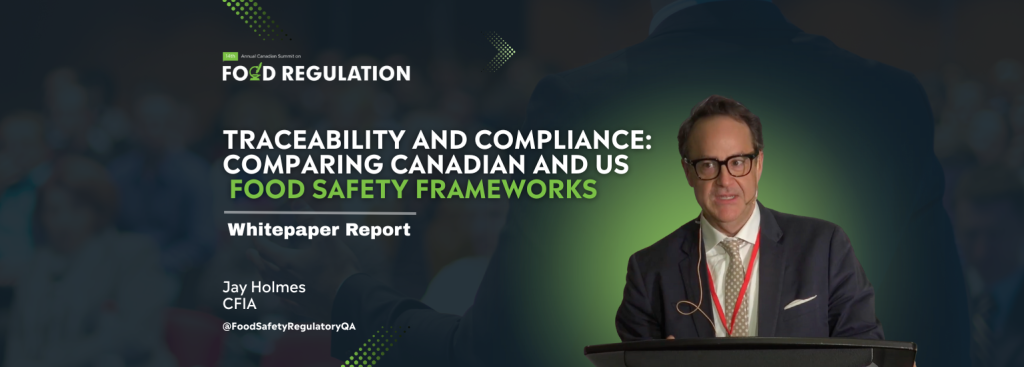Executive Summary
The global food safety landscape is undergoing a profound transformation, driven by technological innovation, shifting trade dynamics, and evolving consumer expectations. As supply chains grow more complex and cross-border trade expands, robust traceability systems have become critical to protecting public health, maintaining consumer trust, and ensuring regulatory compliance.
This whitepaper delivers a detailed comparative analysis of Canadian and US food safety traceability requirements, highlighting key similarities, differences, and emerging trends. It equips food manufacturers, suppliers, and regulators with actionable insights to navigate a complex regulatory environment and build resilient, future-ready compliance strategies.
1. Regulatory Landscape Overview
Food safety regulation in Canada and the United States has evolved over decades, shaped by public health crises, scientific advances, and economic imperatives. While both countries share a common commitment to safeguarding the food supply, their regulatory frameworks reflect unique legal, cultural, and institutional contexts.
In Canada, the Canadian Food Inspection Agency (CFIA) has adopted an adaptive approach, balancing strict food safety oversight with industry collaboration and flexibility. As Jay Holmes, Director at the CFIA, noted in his recent keynote address, the next 12 to 18 months will mark a critical phase of regulatory transformation, focusing on mandate alignment, fiscal efficiency, and innovative compliance pathways.
In the United States, the Food Safety Modernization Act (FSMA) represents the most sweeping reform of US food safety laws in over 70 years. Its proactive, prevention-based model shifts the focus from reacting to foodborne illness outbreaks to preventing them before they occur. By contrast, Canada’s Safe Food for Canadians Act (SFCA) emphasizes shared responsibility and industry engagement, providing businesses with tools to implement customized, risk-based food safety programs.
2. Traceability Requirements: A Comparative View
Traceability is now a cornerstone of modern food safety frameworks. It enables rapid response to contamination events, minimizes public health risks, and protects brand integrity in an increasingly transparent marketplace.
United States: Under FSMA, the FDA’s Final Rule on Requirements for Additional Traceability Records for Certain Foods (Rule 204) mandates stricter record-keeping for high-risk foods, expanding both the scope and granularity of traceability data. Companies must maintain and share detailed Key Data Elements (KDEs) and Critical Tracking Events (CTEs) across the supply chain to ensure swift, accurate recalls when necessary.
Canada: The SFCA already requires businesses to trace food one step forward and one step back in the supply chain. However, the CFIA is actively reviewing ways to modernize these requirements, aiming for greater alignment with international standards while avoiding excessive administrative burdens. Unlike the FDA’s prescriptive approach, the CFIA’s model allows more flexibility in how traceability systems are implemented, offering opportunities for tailored solutions.
Key areas of divergence include:
-
Record-Keeping Depth: FSMA’s Rule 204 sets detailed data requirements, while Canadian rules currently provide more general guidance.
-
Technology Adoption: The FDA strongly encourages digital traceability tools; Canada’s framework is moving in this direction but remains flexible.
-
Reporting Frequency: The US framework mandates real-time or near-real-time data readiness for certain foods; Canada emphasizes timely but less prescriptive reporting.
-
Enforcement and Oversight: US penalties for non-compliance can be more severe, with higher inspection frequencies for non-conforming facilities.
3. Emerging Trends Shaping Traceability
Regulators in both countries are adapting to powerful forces reshaping food safety oversight:
-
Technological Innovation: Blockchain, IoT sensors, AI, and cloud-based platforms are enabling end-to-end visibility and faster response times.
-
Global Trade Pressures: As supply chains become more globalized, harmonization with Codex Alimentarius and international partners grows increasingly important.
-
Consumer Demands: Shoppers expect transparency about where food comes from, how it’s produced, and how it’s kept safe.
-
Novel Food Technologies: The rise of lab-grown proteins, alternative ingredients, and new processing methods demands new compliance frameworks that encourage innovation without compromising safety.
Canada’s forward-looking stance focuses on building regulatory agility, so businesses can bring new products to market while maintaining public confidence in food safety standards.
4. Compliance Strategies for Manufacturers
To remain competitive and compliant, food companies must design robust, adaptive traceability and compliance strategies.
Technology Integration:
-
Deploy advanced tracking and tracing tools that integrate seamlessly across suppliers and distributors.
-
Use cloud-based systems for secure, real-time data sharing.
-
Implement scalable solutions that can evolve with regulatory changes.
Proactive Regulatory Engagement:
-
Maintain open lines of communication with regulators to stay ahead of updates.
-
Participate in industry consultations and pilot programs.
-
Embed regulatory intelligence into business planning.
Risk Management and Continuous Improvement:
-
Develop clear, auditable traceability protocols covering raw ingredients to finished products.
-
Conduct regular internal audits and scenario-based recall simulations.
-
Foster a culture of accountability and continuous improvement across operations.
5. Case Studies
The whitepaper features practical case studies of manufacturers successfully navigating these frameworks:
-
A Canadian processor leveraging blockchain for real-time supply chain visibility.
-
A US producer implementing AI-based predictive analytics to identify and mitigate contamination risks.
-
A multinational brand aligning traceability systems to meet both CFIA and FDA standards without duplicating effort.
Recommendations
-
Build Flexible Traceability Infrastructure
-
Prioritize interoperability across partners and markets.
-
Future-proof systems for new regulatory requirements.
-
-
Champion a Culture of Learning and Adaptation
-
Train staff on emerging compliance standards and technologies.
-
Encourage cross-functional collaboration between QA, operations, and IT.
-
-
Invest in Innovation to Drive Compliance and Efficiency
-
Explore AI, IoT, and blockchain solutions to automate and strengthen traceability.
-
Use data analytics to turn compliance information into actionable business insights.
-
Conclusion
As Canada and the United States continue to modernize food safety regulations, traceability is no longer optional—it’s a strategic imperative. Forward-thinking manufacturers will seize this moment to build trust, strengthen operations, and turn compliance into a competitive advantage.
This whitepaper is based on the 2024 Food Regulation Summit closing keynote session, featuring Jay Holmes of the CFIA.


